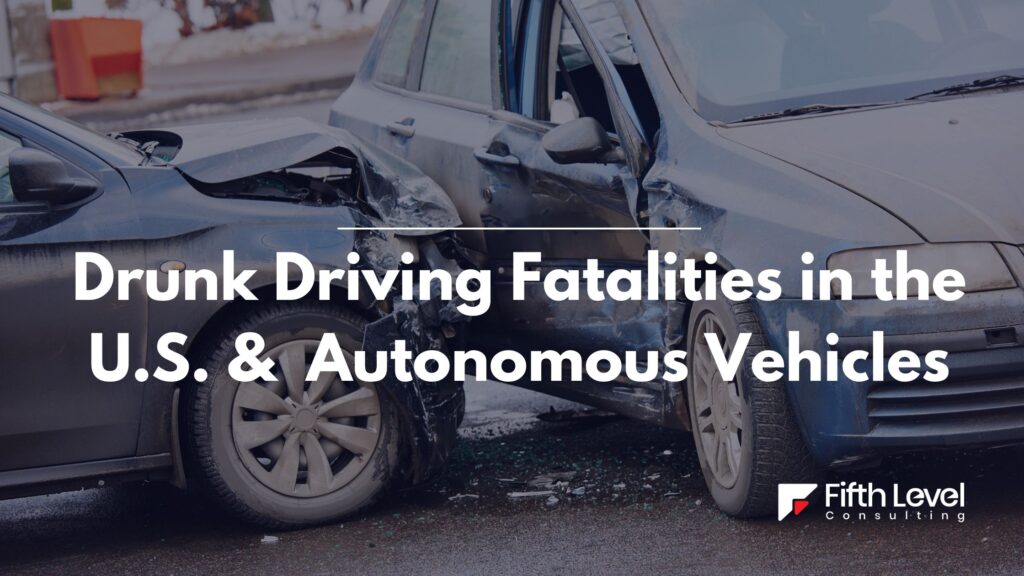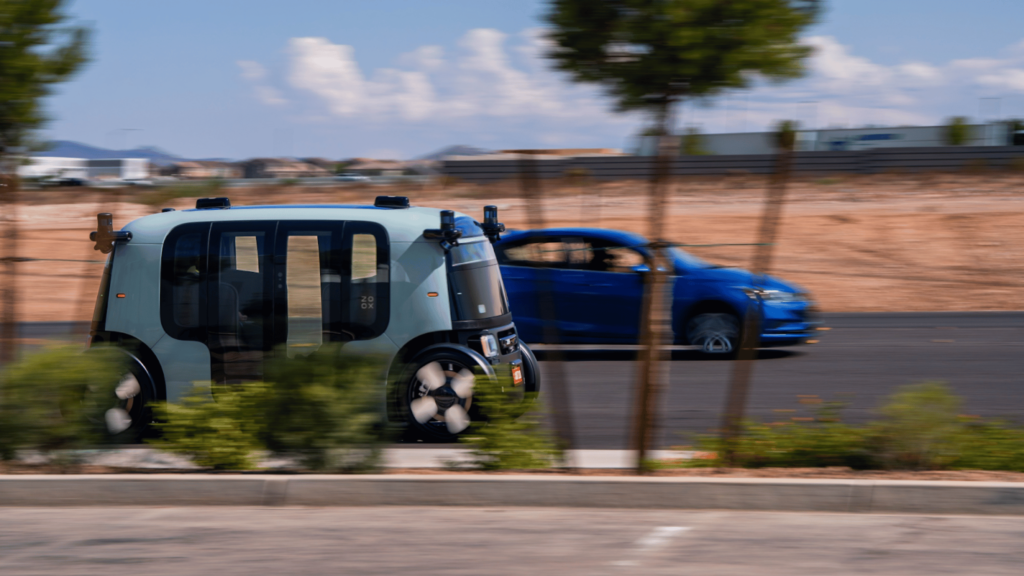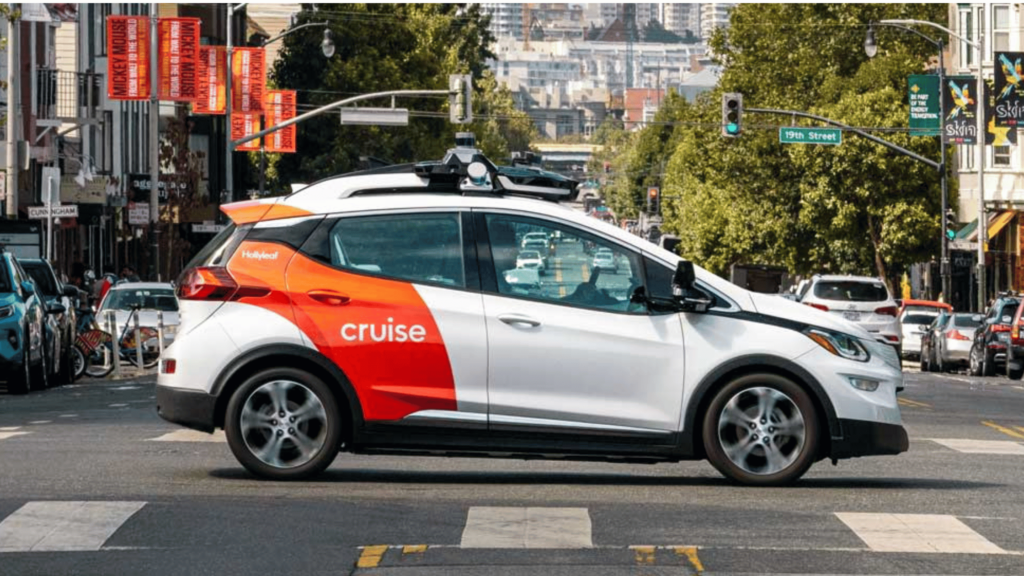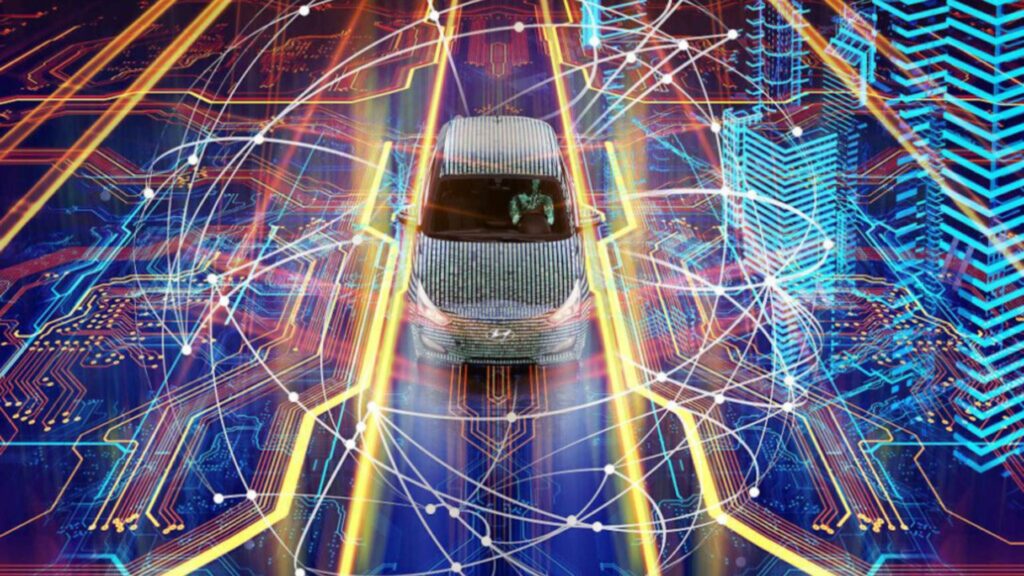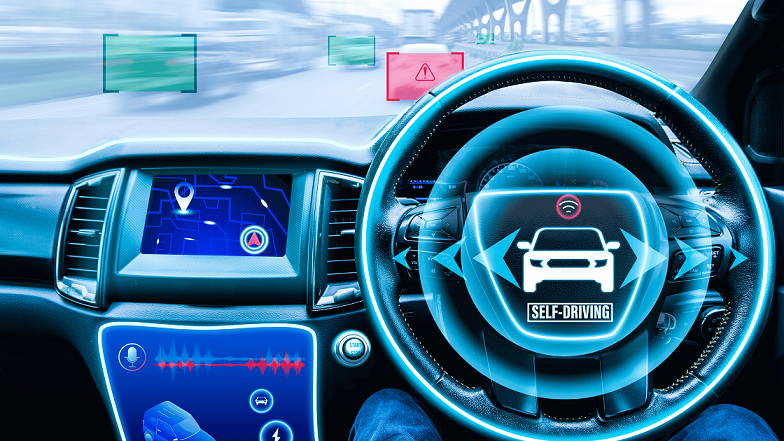- Every day, about 34 people die in drunk driving crashes, according to the NHTSA.
- Autonomous vehicles (AVs) could prevent up to 9,400 alcohol-related deaths annually once widely adopted (IIHS).
- Ride-hailing AVs are already reducing DUIs in early deployment cities like San Francisco, Phoenix, and Austin.
- Autonomous vehicles don’t drink. They don’t get tired. They don’t text, rage, or nod off.
Every year, thousands of lives are lost to a preventable tragedy—drunk driving. Despite decades of awareness campaigns, stricter laws, and advancements in vehicle safety, alcohol-impaired driving remains a leading cause of death on American roads. In 2023 alone, 12,429 people lost their lives in crashes involving drunk drivers, accounting for nearly 32% of all traffic fatalities. To put this in perspective, someone died in a drunk driving accident every 42 minutes in 2023. Behind these staggering numbers are families shattered, futures cut short, and a societal problem that demands innovative solutions.
Beyond the loss of life, the economic burden is staggering. The Centers for Disease Control and Prevention (CDC) estimates that alcohol-related crashes cost over $44 billion annually in emergency services, lost productivity, legal costs, and property damage.
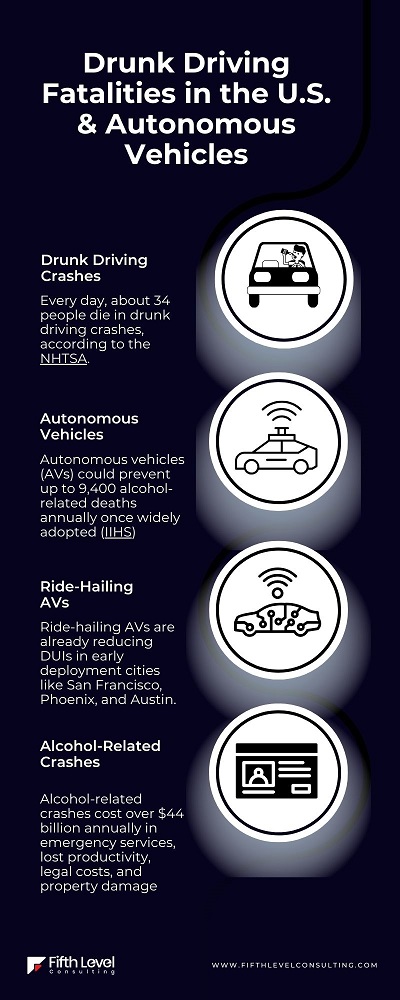
Historical Context and Current Trends
While drunk driving fatalities have decreased significantly since the 1980s, progress has stagnated in recent years. In 2023, the rate of alcohol-impaired driving fatalities per 100,000 population was 3.7, representing a 59% decrease since 1982. However, drunk driving killed more than 12,000 people for the second year in a row, indicating that traditional enforcement and education methods may be reaching their limits.
The persistence of this problem becomes even more troubling when we consider that three out of four drunk offenders continue to drive after their license has been suspended. This reality underscores the need for technological interventions that can prevent impaired individuals from operating vehicles altogether.
And that’s where autonomous vehicles come in.
Self-driving cars have evolved from sci-fi fantasy to a tangible lifeline in this fight against drunk driving. Companies like Waymo, Zoox, and Tesla are proving that AVs aren’t just about convenience—they’re about saving lives. Early data shows that autonomous ride-hailing services have already logged millions of miles with zero alcohol-related incidents, offering a glimpse of a future where impaired driving could become rare.
The Sobering Reality of Drunk Driving in the US
By the Numbers: A National Crisis
- 13,524 deaths in 2022 involved alcohol-impaired drivers (BAC ≥ 0.08%) (NHTSA).
- Over 230,000 injuries yearly from drunk driving crashes (CDC).
- Economic toll: $68.9 billion annually in medical costs, legal fees, and lost productivity (NHTSA).
Who’s Most at Risk?
- Young drivers (21-34): Responsible for 27% of drunk driving fatalities (IIHS).
- Repeat offenders: Nearly 25% of convicted drunk drivers reoffend (FBI).
- Nighttime & weekends: 55% of fatal crashes between midnight and 3 AM involve alcohol (NHTSA).
Why Traditional Measures Aren’t Enough
- Ignition interlocks (breathalyzers in cars) are only mandated for repeat offenders in some states.
- Ride-hailing helps, but isn’t universal—rural areas and cost barriers limit accessibility.
- Public awareness campaigns haven’t stopped the 3.3% rise in drunk driving deaths since 2021.
“We’ve made progress, but we’re stuck in a cycle of enforcement and tragedy. Technology can break that cycle.”
—Jessica Cicchino, VP of Research, IIHS
Understanding the Human Factor in Vehicular Carnage
Drunk driving persists because it’s fundamentally a human behavioral problem. Alcohol impairs judgment, reaction time, and motor coordination—exactly the faculties needed for safe driving. When someone is intoxicated, their ability to make rational decisions about whether they should drive is compromised.
The psychological phenomenon of optimism bias also plays a role. Intoxicated individuals often overestimate their driving abilities and underestimate the risks they pose to themselves and others. This cognitive distortion has proven remarkably resistant to traditional deterrent measures like fines, license suspensions, and even jail time.
How Autonomous Vehicles Are Changing the Game
Autonomous vehicles are potential game-changers in our battle against drunk driving fatalities. These sophisticated machines don’t get tired, don’t get distracted, and certainly don’t get intoxicated. They represent a paradigm shift from relying on human judgment to leveraging advanced sensor arrays, machine learning algorithms, and artificial intelligence.
Autonomous vehicles utilize a complex constellation of technologies including lidar, radar, cameras, and GPS systems to navigate roads safely. Unlike human drivers, these systems don’t suffer from the physiological and cognitive impairments that alcohol causes.
The technology continuously monitors the vehicle’s surroundings, processes information at superhuman speeds, and makes split-second decisions based on programmed safety protocols. There’s no opportunity for the vehicle to make the poor decision to drive while impaired—because the vehicle itself is the driver.
Waymo’s fifth-generation autonomous system, for example, interprets complex driving environments in Phoenix, San Francisco, and Austin without human input. It has driven millions of miles autonomously and reported zero fatalities caused by its system to date.
A landmark study by the RAND Corporation estimates that widespread adoption of AVs could reduce traffic fatalities by up to 90%, translating to over 30,000 lives saved annually in the U.S. alone.
Another 2021 study by IIHS (Insurance Institute for Highway Safety) found that even AVs that only eliminate impaired driving could prevent one in four fatal crashes.
That’s over 10,000 lives saved every year—just by taking drunk drivers out of the equation.
“The promise of autonomous vehicles isn’t just convenience. It’s about the lives we can save, the families we can keep whole.” _ Deborah Hersman, former chair of the NTSB
Table Showcasing Autonomous Vehicle Technology as a Solution to Drunk Driving Fatalities in the U.S.
| Variable / Aspect | Current State of Drunk Driving in the U.S. | Autonomous Vehicle (AV) Solution | Potential Impact / Benefits of AVs | Challenges and Considerations for AVs |
| Fatalities (Annual) | Approximately 12,429 deaths in 2023 due to alcohol-impaired driving crashes. (NHTSA) | AVs remove the human driver, eliminating the possibility of a vehicle being operated by an impaired individual. | Near elimination of drunk driving fatalities. A significant reduction in the leading cause of traffic deaths. | Partial vs. Full Autonomy: Most current AVs (SAE Levels 1-3) still require human oversight. Impaired drivers could still cause accidents if they fail to take control when needed. |
| Frequency | One person dies every 42 minutes in a drunk-driving crash. (NHTSA) | AVs operate on programmed rules and sensor data, free from the influence of alcohol. | Constant vigilance: AVs maintain consistent, non-impaired driving, 24/7. | System Failures & Hacking: While rare, AV software or hardware failures, or malicious hacking, could still lead to accidents, regardless of driver sobriety. |
| Cause of Accidents | ~30% of all traffic crash fatalities involve drunk drivers (BAC ≥ 0.08 g/dL). 94% of all road accidents are attributed to human error (NHTSA). | AVs eliminate human error as a factor in driving. They are designed to adhere to traffic laws and react optimally. | Reduced Human Error: Addresses a significant root cause of all accidents, not just those involving alcohol. | Regulatory & Legal Frameworks: Current DUI laws are designed for human drivers. New laws are needed to address liability and responsibility in AVs, especially in the context of impaired occupants. |
| Risk Factors | Impaired judgment, slower reaction times, reduced coordination, and increased risk-taking are common with alcohol consumption. | AVs utilize advanced sensors (LiDAR, radar, cameras), sophisticated algorithms, and faster processing capabilities than humans. | Enhanced Perception & Reaction: AVs have 360-degree vision, can detect hazards more quickly, and react faster than human drivers. | Public Acceptance & Trust: Consumers need to trust the technology to adopt it widely. Misconceptions or incidents involving AVs can hinder public acceptance. |
| Mobility for Impaired Individuals | Impaired individuals are often left with limited safe transportation options, increasing the likelihood of driving drunk. | AVs provide a safe, convenient, and accessible transportation alternative for anyone, including those who have consumed alcohol. | Safe Alternative: Individuals can use AVs as a “designated driver” service, removing the temptation to drive after drinking. | Behavioral Changes: Some studies suggest AV availability could lead to increased overall alcohol consumption if individuals feel less constrained about getting home. |
| Societal Cost | Drunk driving crashes cost the U.S. an estimated $68.9 billion annually (2019 numbers). (NHTSA) | Reduced accidents mean lower healthcare costs, insurance premiums, emergency service strain, and lost productivity. | Significant Economic Savings: Billions of dollars saved annually from fewer crashes, injuries, and fatalities. | Infrastructure Investment: Widespread AV adoption requires significant investment in smart infrastructure and charging networks. |
| Prevention Methods (Current) | Law enforcement (DUI checkpoints, arrests), public awareness campaigns (MADD), ignition interlocks, stricter laws. | Integration of AVs with existing traffic management systems and data sharing for optimal traffic flow and safety. | Proactive Prevention: AVs prevent impaired driving rather than reacting to it. | Cost of AVs: The initial cost of fully autonomous vehicles and their maintenance may limit widespread accessibility for some time. |
| Future Outlook | Continued, albeit slow, reduction in fatalities with current methods. | As AV technology matures and becomes widespread, drunk driving fatalities could become a rarity. | Vision Zero Potential: A step closer to the ultimate goal of zero traffic fatalities. | Ethical Dilemmas: Programming AVs for unavoidable accident scenarios (e.g., choosing between two bad outcomes) presents complex ethical challenges. |
Investment and Market Growth
The AV market is growing, valued at $54 billion globally. According to a report by Allied Market Research, the global autonomous car market will likely reach $556.67 billion by 2026, growing at a CAGR of 39.47% from 2019 to 2026. The increasing demand for safer and more efficient modes of transportation drives this rapid growth. However, as with any new technology, there are concerns about the safety and reliability of autonomous cars.
Advocacy Organization Support
Organizations like Mothers Against Drunk Driving (MADD) have embraced autonomous vehicle technology as a potential solution. MADD strongly supports the safe development of autonomous vehicles and works to build public acceptance for the adoption of this life-saving technology.
This support from advocacy groups is crucial for public acceptance of autonomous vehicles. When organizations that have been fighting drunk driving for decades endorse these technologies, it lends credibility to their safety potential.
Policy, Infrastructure, and Public Will
For AVs to be an effective countermeasure to drunk driving, policymakers must accelerate:
- AV-friendly legislation and safety standards
- Public-private partnerships to deploy AVs in ride-hailing fleets
- Funding for smart infrastructure that supports vehicle-to-everything (V2X) communication
- Equity-focused AV access for vulnerable and high-risk populations
States like California, Texas, and Arizona are already laying the groundwork, with driverless ride services operating in select cities. The federal AV START Act, though stalled, signals national interest in regulating this frontier responsibly.
Adoption Timeline and Accessibility
The transition to autonomous vehicles will likely take decades. Even if the technology becomes perfect tomorrow, it would take years for the vehicle fleet to turn over. During this transition period, traditional drunk driving countermeasures remain essential.
Additionally, autonomous vehicles must be accessible to all economic segments of society to maximize their safety benefits.
The Road Ahead
The path to eliminating drunk driving fatalities through autonomous vehicles is complex but achievable. Success will require continued technological development, supportive regulatory frameworks, and public acceptance of these emerging transportation modes.
While we wait for fully autonomous vehicles to become mainstream, hybrid approaches show promise. Advanced driver assistance systems (ADAS) that can detect impairment and prevent vehicle operation are already being developed. These systems could bridge the gap between current technology and fully autonomous vehicles.
The fight against drunk driving fatalities has been long and difficult, but autonomous vehicle technology offers unprecedented hope. While challenges remain, the potential benefits are too significant to ignore. Every family that doesn’t have to experience the heartbreak of losing a loved one to a drunk driver represents a victory worth pursuing.
You May Also Like:
6 Best Self-Driving Cars in the US (2025)
Top 5 Autonomous Trucking Companies in the US (2025)

I’m Dr. Brandial Bright, also known as the AVangelist. As a dedicated and passionate researcher in autonomous and electric vehicles (AVs and EVs), my mission is to educate and raise awareness within the automotive industry. As the Founder and Managing Partner of Fifth Level Consulting, I promote the adoption and innovation of advanced vehicle technologies through speaking engagements, consulting, and research as we progress to level 5 fully autonomous vehicles.

